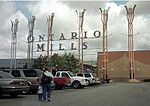Rancho Cucamonga station
1994 establishments in CaliforniaBus stations in San Bernardino County, CaliforniaCalifornia railway station stubsMetrolink stations in San Bernardino County, CaliforniaRailway stations in the United States opened in 1994 ... and 2 more
Rancho Cucamonga, CaliforniaUse mdy dates from November 2023

Rancho Cucamonga station in Rancho Cucamonga, in San Bernardino County, California, serves the Metrolink San Bernardino Line commuter rail. With the proposed Brightline high-speed rail and a potential underground tunnel project to Ontario International Airport, local officials expect increased tourism and economic growth for the Inland Empire. The station is owned by the City of Rancho Cucamonga and is near the former Empire Lakes Golf Club. It is located just west of Milliken Avenue and has 330 parking spaces.
Excerpt from the Wikipedia article Rancho Cucamonga station (License: CC BY-SA 3.0, Authors, Images).Rancho Cucamonga station
Azusa Court, Rancho Cucamonga
Geographical coordinates (GPS) Address External links Nearby Places Show on map
Geographical coordinates (GPS)
| Latitude | Longitude |
|---|---|
| N 34.0918 ° | E -117.5599 ° |
Address
Rancho Cucamonga
Azusa Court
91739 Rancho Cucamonga
California, United States
Open on Google Maps






